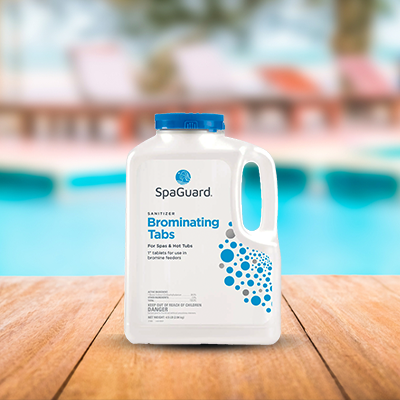- Sku:
Spaguard Brominating Tablets
The power of an organic brominating compound (BCDMH) compressed into 1-inch tablet. These tablets are acidic and may lower pH, so pH and total alkalinity should be tested frequently and adjusted as necessary. Use Brominating Tablets in a brominator or in a SpaGuard Floating Dispenser.
Dissolve slowly and protect continuously.
Particularly good for commercial spas and other spas with big bather loads.
96% 1-bromo-3-chloro-5, 5-dimethylhdantoin (BCDMH)
pH 4.5
No chlorine odor
Less pH sensitive
Applied through tablet floater or brominator
Directions for use:
1. Fill spa bromine feeder and adjust feeder following manufacturer's directions
2. Keep feeder filled to maintain 2-4 ppm in residential spas. (Commercial spas should maintain 4-6ppm)
3. Keep water free of leaves and other debris
4. Pump and filter should be operated a minimum of 3 hours per day whether spa is used or not.


For more information on Spa Guard products, please watch this informational video.
PRODUCT FAQ'S
The force and velocity of aerated water keeps water moving so the filter can remove suspended debris. Circulation also ensures that the chemicals are thoroughly distributed. Dead spots are usually not as prevalent in a spa as they are in a pool.
With the dirt, sweat and oils released in a spa, good filtration is essential. Cartridge filters are the typical choice and because of the increase in the amount of filterable debris, the filter should be regularly cleaned with a garden hose or chemically cleaned at refill.
Cleaning a spa involves several aspects of care, including the removal of obvious debris by skimming or vacuuming, and removal of body oils that are rinsed off bathers. Also, be sure to wipe surfaces after heavy use.
Bacteria and algae grow much faster in a spa than in a pool. As a result, spa owners need to follow a regular and complete chemical treatment routine. Spa chemistry includes water balance, sanitizer and oxidizer applications.
Fewer gallons of water mean changes in water balance happen faster. Add to this the aerated water, increased water temperature, and the heavier bather loads, and it’s easy to see the importance of regular testing. Adjust the balance and sanitizer levels as needed.
Sooner or later, the water reaches a point where it just gets “worn out” from the bather load. When the water looks bad, smells bad, and feels bad it’s time for a change. It is recommended that you drain and refill your spa with fresh water approximately every 3 months.
Spaguard Brominating Tablets



